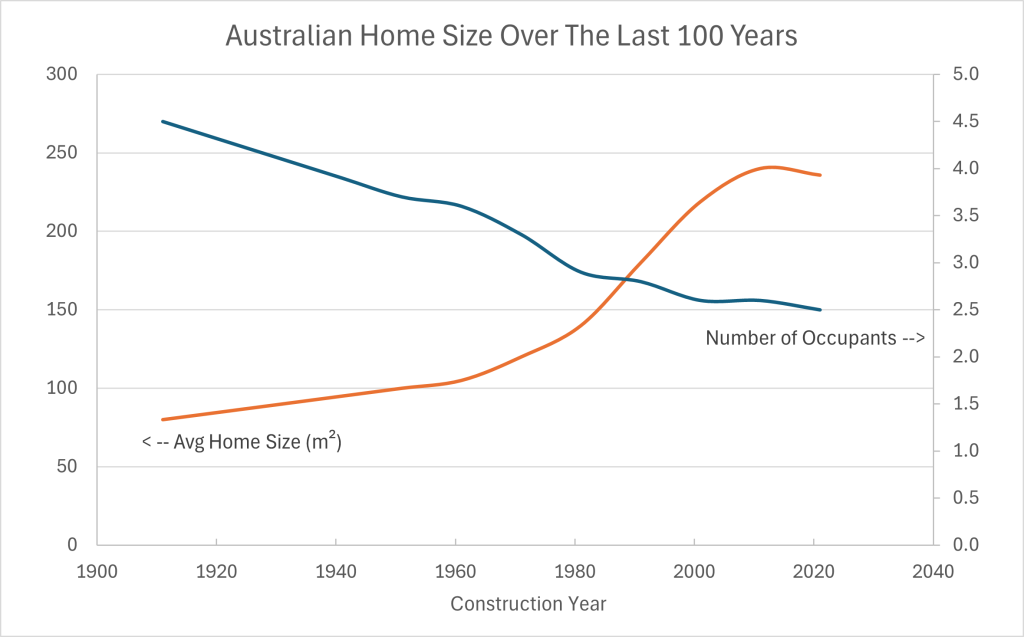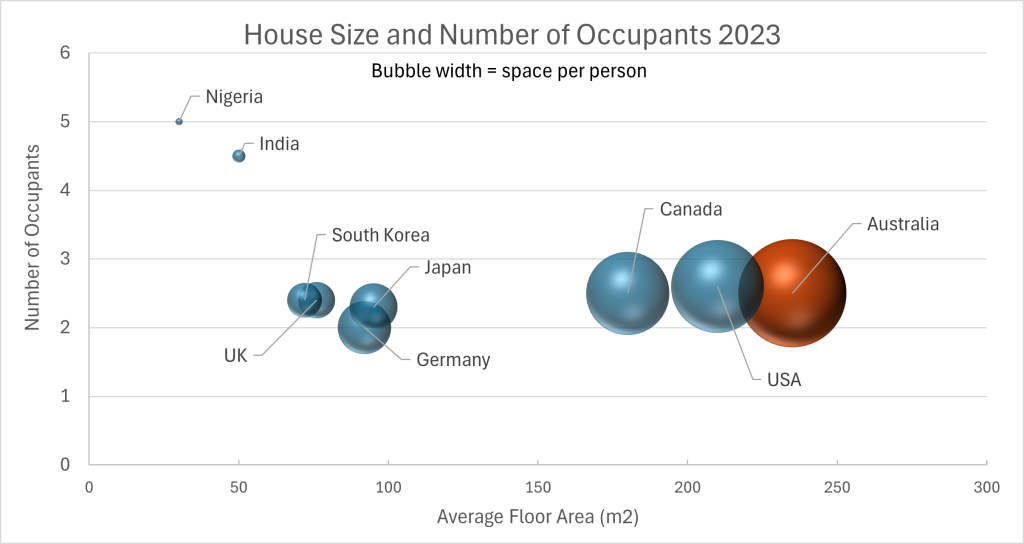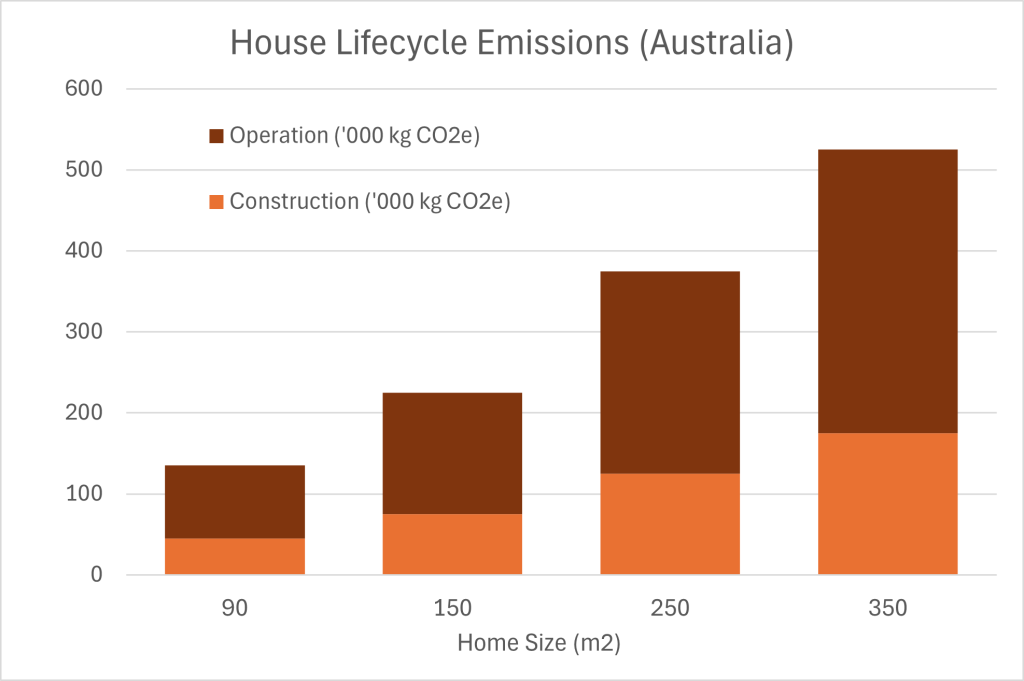
We live in one of the most spacious countries on Earth, and yet we often feel squeezed. Squeezed by time, by debt, by loneliness. In a nation where new homes average over 230 square metres and number of occupants is shrinking, it’s worth asking: what are we really gaining from all that extra space?
This post is a gentle challenge. Not to shame anyone for having a big home, but to reflect on what homes are really for—and whether bigger truly means better. Even if you love the home you’re in, if you have children you’re no doubt thinking about how they’re going to afford a home of their own.
A Century of Expansion: More Room, Fewer People
Over the last century, Australian homes have ballooned in size. In 1911, the average house was just 80m² and housed more than four people. By 2021, the average new house measured 235.8m² with only 2.5 people living in it. [ABS]
This means that while the physical footprint of our homes has tripled, the number of people inside them has nearly halved. The result? A staggering increase in space per person—from under 18m² in 1911 to more than 94m² in 2021.

And globally, this trend is not the norm. In the UK, people live in homes averaging just 76m²【ONS】.
Australia now leads the world in per-person floor space. At 94m² per person, it is more than double the global average.

Our “Small” Home: A Reflection
Our family of four lives in a 90m² house. Less than half the national average for a family home. Sometimes I feel a bit embarrassed when we have guests and I can give them a full tour from the front door, but it is really enough. Any shame I feel is because I’m comparing my circumstances to assumed values of my guests, rather than my own or further afield.
In fact, even with the small space, it’s felt best when we’ve had another adult living with us. Those seasons of shared living created moments of connection we still talk about and at times long for.
We did, at one point, seriously consider raising the house to add more space. Partly out of pride, partly out of an assumed need, partly just because we could. But after several years of deliberation and a couple of false start, we couldn’t justify it. Not the cost. Not the added cleaning. And especially not when we considered what that same money, $250,000 or more, could do for others, and has started to.
According to The Life You Can Save this could fund hundreds of cataract surgeries, protect thousands of children from malaria, or facilitate 1000s of years of schooling. So instead, we leaned into enough.
The Hidden Cost of Bigger Homes
Thinking of building or renovating? That spare room for visitors, the media room, the gym. It’s easy enough to add 100m² to your plans, your dream home. But it might cost you more than you realise.
A $250,000 extension or additional construction cost, at 6% interest, could add $1,500 to your monthly repayments over 30 years [ABS]. If you earn average wages, that’s an extra 1 to 2 days of work every single week for 30 years, just to cover the cost of space you’ll rarely use [ABS]. Do you love your in-laws that much?
$540,000 additional cost over 30 years.
And what does that mean in the long run?
- More hours at work, fewer at home.
- More years in the workforce, fewer with your grandkids.
- More money to banks, less to spend on experiences, connection, or purpose.
As housing becomes more expensive, we’re not just spending more—we’re working more, and living less.
Isolated by Design? Social Impacts of Oversized Living
More space doesn’t always mean more connection. In fact, research suggests the opposite. Larger homes can fragment family life. Everyone retreats to their own wing, their own screen, their own silence.
Smaller homes encourage proximity. Conversations flow more naturally. Meals are shared more often. Children learn to negotiate space and emotion. Parents are more present by default. And when we want space away from others, we’re more likely to take it outside, bringing other benefits. One hack that has also helped keep everyone sane when a few people are excitable and others need peace is good acoustic isolation on the bedrooms, particularly the doors (usually the weakest link).
Outside the front door, the trend toward oversized houses on oversized lots contributes to urban sprawl and car dependence. Fewer footpaths. Longer commutes. Less neighborly interaction. If we have everything we need at home, why go out?
As Tim Ross notes in his reflections on Australia’s shifting housing culture, we’ve moved from modest, socially vibrant homes to oversized investments built for isolation:
“It’s the shift from home life to home-as-asset that’s pulled us away from the things that matter most”【The Guardian】.
The Green Illusion: Why Eco Homes Aren’t the Answer
Sustainable building is a step forward. But we must be honest: even the greenest home, at Australian scales, carries a massive environmental cost.
The construction industry accounts for nearly 40% of global carbon emissions when you include embodied energy in materials like concrete, steel, and insulation [GlobalABC]
Heating and cooling large homes consumes more energy, even when powered by renewables. Maintenance, furnishings, and future demolition add further waste.
A modest, well-insulated, retrofitted home, especially one that’s shared, is almost always the greener option. And there is no doubt that the greenest square metre is the one that is never built.

What Would You Do With An Extra $18,000 per Year or a Long Weekend Every Week?
This isn’t about deprivation. It’s about possibility.
- Could you go to more special activities with your children?
- Could you find the time to walk, cycle or take public transport and reduce the stress of your commute
- Could that extra room become someone else’s shelter, bringing a sense of community back into your home
- Could you redirect the saved money toward generosity or purpose?
By downsizing or doing without upgrades, you could:
- Take a year off to travel with your children.
- Fund effective charities that literally save lives.
- Volunteer more. Sleep better. Be present.
Final Thoughts
In a culture that often says “more,” choosing “enough” can feel radical.
But enough is spacious. It’s where contentment lives. It’s where we rediscover the value of shared spaces, shared stories, and shared futures.
So maybe the question isn’t “Should we upsize?” but “What do we want more of?” More connection? More purpose? More time?
Because those things don’t come from square metres. They come from how we choose to live in the space we already have.
